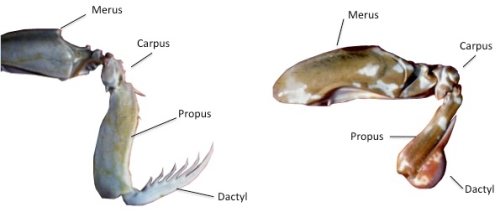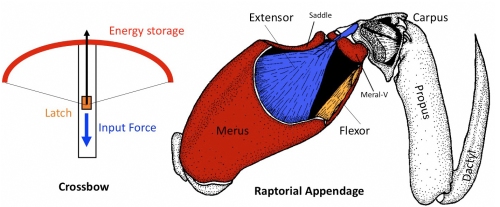Stomatopods, or mantis shrimp, are an exceptional order of marine crustaceans made up of over 500 species that live in a variety of benthic habitats around the world. They are aggressive predators that actively seek out their prey with an advanced suite visual and chemosensory organs. Stomatopods are immediately distinguished by a pair of enlarged raptorial appendages located ventrally, near their heads. Stomatopods use these appendages as their primary means of predation, as well as for digging in substrate, defense, and intraspecific sparring.
The appearance of the raptorial appendages varies from species to species as they are evolutionarily specialized for capturing or killing distinct prey animals. The raptorial appendages can be deployed at lightning speeds, and with tremendous force relative to the size of the stomatopods; which can range from under 2 cm to 40 cm body length. Depending on the species, these appendages can be employed to smash, spear, or grab their prey.
Here are video examples of “smasher” and “sprearer” stomatopods in action:
Odontodactylus scyllarus smashes the shells of mollusks and crustaceans.
Lysiosquillina maculata ambushes swimming fish and crustaceans, spearing them out of the water column. Click through to Youtube to see this one.
Since the 1960’s, a series of research has unraveled the speed, power, and mechanics of the stomatopod’s astonishing attack.
The raptorial appendages of the mantis shrimp are reminiscent of the forearms of the terrestrial preying mantis, from which their name is derived. All stomatopod raptorial appendages are constructed from the same four segments; the merus, the carpus, the propus, and the dactyl. The appearance of these raptorial appendages varies (especially in regards to the dactyl component) from species to species as evolution has specialized them for killing or capturing different types of prey. Some mantis shrimp have spear like barbs on their raptorial appendages, excellent for reaching out and snagging fish out of the water column. Others have developed a hardened, club-like heal on the “elbow” of their raptorial appendages, ideal for some serious shell smashing.
 The raptorial appendages of spearer (Lysiosquillina maculata) and smasher (Odontodactylus scyllarus) stomatopods. Adapted from a photo by Roy Caldwell.
The raptorial appendages of spearer (Lysiosquillina maculata) and smasher (Odontodactylus scyllarus) stomatopods. Adapted from a photo by Roy Caldwell.
Rather than using sustained crushing force to break open hard bodied prey, “smasher” stomatopods use extremely quick, forceful smashing blows delivered by the heel of their dactyls. The dactyls on the end of the stomatopod raptorial appendage are propelled forward at surprisingly high speeds and with tremendous force. In O. scyllarus, the raptorial appendages can rapidly accelerate to speeds in excess of 20 meters per second. The impact force of the O. scyllarus smasher against a flat surface was measured as high as 1500 Newtons, or nearly 340 pound force.
Furthermore, in addition to the initial impact of a smashing strike, the speed of the striking dactyl generates a phenomenon called cavitation in the water at the point of impact. Cavitation is the result of fluids moving rapidly in disparate directions. At the interface of the fluid movement, extremely low pressures cause the formation of a cavitation bubble. As a stomatopod strikes its target, a cavitation bubble forms at the point of impact. As the bubble collapses against the target it generates an additional smashing force, as high as 590 Newtons, about 0.5 milliseconds after the dactyl’s initial hit.
Here is a high-speed video recording of O. scyllarus striking a snail shell. Notice the cavitation bubble forming and then collapsing at the point of impact:
Now here is a the same animal striking a force sensor along with the force sensor output. Notice the secondary force peak created by cavitation:
How do stomatopods generate such incredible force? It turns out that the strike mechanism is actually akin to the principals behind a crossbow. A crossbow has a latch that holds the arrow in place as force is input by ratcheting it backwards. Potential energy is built up and stored in the bow. When the latch is triggered to release, the potential energy sequestered in the bent bow is transferred to the arrow, propelling it forward.
Similarly, in the stomatopod’s raptorial appendage, a flexor muscle is attached to a hardened latch mechanism that holds the cocked propus and dactyl in place. Then, a large extensor muscle ratchets up force that is stored throughout the exoskeleton of the merus; particularly in specialized structures known as saddle and meral-V. Finally, the flexor muscle relaxes, releasing the latch, transferring the stored energy through a four-bar linkage mechanism, and propelling the propus and dactyl forward at ludicrous speeds.
 Cutaway of Hemisquilla raptorial appendage showing internal musculature. Adapted from: Burrows, 1969.
Cutaway of Hemisquilla raptorial appendage showing internal musculature. Adapted from: Burrows, 1969.
For a while, the stomatopod strike was the fastest known movement in the animal kingdom. Recently however, it was supplanted by a trap-jaw ant. Regardless, the stomatopod achieves its strike in an aqueous medium and would totally dominate those puny ants (I’m biased, I know).
For more, watch this great TED talk about stomatopod strike research by Sheila Patek. Also, check out my previous posts about mantis shrimp: Stomatopods.
References:
- Burrows M. 1969. The Mechanics and Neural Control of the Prey Capture Strike in the Mantid Shrimps Squilla and Hemisquilla. Zeitschrift Fuer Vergleichende Physiologie 62: 361-381.
- Patek SN, and Caldwell RL. 2005. Extreme impact and cavitation forces of a biological hammer: strike forces of the peacock mantis shrimp Odontodactylus scyllarus. The Journal of Experimental Biology 208: 3655-3664.
- Patek S, Korff W, and Caldwell R. 2004. Deadly strike mechanism of a mantis shrimp. Nature 428: 819-820.
- Patek S, Nowroozi B, Baio J, Caldwell R, and Summers A. 2007. Linkage mechanics and power amplification of the mantis shrimp’s strike. The Journal of Experimental Biology 210: 3677-3688.
















Man, those are great videos. Do you know if there have been studies on the phylogeny of the mantis shrimp that would allow generalizations to be made about how ‘smasher’, ‘spearer’, and ‘grabber’ (I assume there are more technical terms, but I don’t know them) species diverged? It would be interesting to see if the different types of appendages are likely to have evolved before or after the divergence of species within the group (order? suborder? I’m a bit shaky with systematics.)
Good question. You can make some pretty solid generalizations about spearers and smashers at the superfamily level (Stomatopods are currently divided into seven superfamilies). However, molecular phylogenetics have shaken things up a bit for the stomatopod order.
This really deserves its own post though. Looks like I have something to write about next week :D.
Actually, there is a new phylogeny in the pipes at the moment, and I’ll hold off on my stomatopod phylogeny post until that gets out.
That was a really joy of a post!!
Dr Z Paul Lorenc, a plastic surgeon sculpt her into a remove cellulite on photoshop younger version
of herself. My cancer’s out of me. Meanwhile, some big-picture efforts may help reduce the duration and severity of cold symptoms.
Hello There. I discovered your weblog using msn. That is a very smartly written article.
I will make sure to bookmark it and return to learn more of your useful info.
Thanks for the post. I’ll certainly comeback.
Awesome! Its really amazing paragraph, I have got much clear idea regarding from this post.